Wk 3 assignment.pdf
- 2. AGENDA ⊠Introduction ⊠What is sanitation ⊠Common waterborne diseases ⊠Sources of contamination ⊠Effect of contaminated water ⊠Multiple barriers approach ⊠Protection of water sources ⊠Protection of water distribution systems ⊠Treatment of water at household level ⊠Key takeaways ⊠References
- 3. INTRODUCTION ⊠This session is about hygiene and sanitation awareness ⊠The target audiences are youth aged 18-30 years ⊠Majority of the youth have limited knowledge about quality of drinking water ⊠The possible health effects of consuming contaminated water remain unknown to them
- 4. WHAT IS SANITATION ⊠Refers to the provision of facilities, services, and conditions to protect public health. ⊠Having access to facilities for safe disposal of wastes including human wastes
- 5. COMMON WATERBORNE DISEASES ⊠Cholera ⊠Typhoid fever ⊠Diarrheal diseases e.g. rotavirus among infants ⊠Hepatitis A
- 6. SOURCES OF CONTAMINATION ⊠Improper wastes disposal ⊠Lack of water treatment or facilities ⊠Natural disasters e.g. flood ⊠Poor sanitation e.g. open defecation ⊠Lack of protection for water sources
- 7. EFFECTS OF CONTAMINATED WATER âĒ Gastrointestinal ailments âĒ Nausea âĒ Skin problems âĒ Birth defects âĒ Stomach ache âĒ Diarrhea âĒ Dehydration (BEdwards, 2016)
- 8. MULTIPLE BARRIER APPROACH ⊠This is a holistic approach that focus on all aspects of water supply system. ⊠It promote protection of water sources ⊠It promote the protection of distribution channels e.g. pipes ⊠It also encourage the treatment of water by the end users
- 9. PROTECTION OF WATER SOURCES ⊠Fencing of water sources ⊠Proper disposal of wastes ⊠Provision of toilet or pit latrine to every household ⊠Avoid locating pit latrine in close proximity with water sources e.g. tap stands or boreholes ⊠Promote watershed management e.g. responsible farming
- 10. PROTECTION OF WATER DISTRIBUTION SYSTEMS ⊠Regular maintenance and repair ⊠Controlling access to distribution systems ⊠Protecting against natural disasters e.g. flood ⊠Regular testing and monitoring
- 11. TREATMENT OF WATER AT HOUSEHOLD LEVEL ⊠Boiling ⊠Chlorination ⊠Filtration ⊠Constant hand wash practice (Regional water provider, n.d.)
- 12. KEY TAKEAWAYS ⊠Lack of sanitation can adversely affect the public health ⊠It can lead to the contamination of water hence reduced water quality ⊠Contamination of water can exacerbated the infection of several waterborne diseases ⊠The best strategy for preventing water contamination is Multiple Barrier Approach (MBA) ⊠MBA aims at preventing contamination of water on three categories namely; source, distribution, and consumption.
- 13. REFERENCES 1. BEdwards. (2016, July 7). The Effects of Drinking Contaminated Water and/or Dirty Water [Photograph]. https://haguewaterofmd.com/. https://haguewaterofmd.com/effects- drinking-dirty-andor-contaminated- water/ 2. Regional water provider. (n.d.). Treating Emergency Water [graphic]. https://www.regionalh2o.org/. https://www.regionalh2o.org/emergency- preparedness/treating-emergency-water
- 14. THANK YOU Chol A. Ariik












![REFERENCES
1. BEdwards. (2016, July 7). The Effects of
Drinking Contaminated Water and/or
Dirty Water [Photograph].
https://haguewaterofmd.com/.
https://haguewaterofmd.com/effects-
drinking-dirty-andor-contaminated-
water/
2. Regional water provider. (n.d.). Treating
Emergency Water [graphic].
https://www.regionalh2o.org/.
https://www.regionalh2o.org/emergency-
preparedness/treating-emergency-water](https://image.slidesharecdn.com/wk3assignment-230527092936-e0384a7b/85/Wk-3-assignment-pdf-13-320.jpg)
